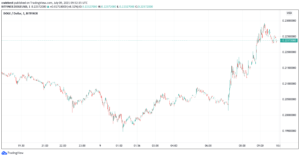If you’re looking for help picking stocks, the Oxford Club and the Motley Fool are two of the most successful investing platforms available today. Each of these sites offers a wide range of stock picking newsletters that are designed to suit different investment styles and goals.
In this guide, we’ll compare the Oxford Club vs. The Motley Fool to help you decide which service is right for you.
Review Contents
About Oxford Club and Motley Fool
The Oxford Club was first established in 1991 by William Bonner, the founder of Agora, Inc., as a private club for expert investors to share ideas. These ideas were published in a monthly newsletter called the Oxford Communique.

Throughout the 1990s, the club expanded to offer additional newsletters, fast-paced trading services, and investment courses on cassette. The company continued to add specialists, such as Marc Lichtenfeld for dividend investing and Porter Stansbury (who now runs Stansbury’s Investment Advisory) for technology investing, to expand its offerings. Today, the Oxford Club continues to offer trading services and monthly newsletters.
The Motley Fool was founded in 1993 by brothers Tom and David Gardner. The brothers wanted to create an investment platform that would buck conventional Wall Street wisdom and invest early in companies that were poised for explosive growth. In 2002, the Motley Fool launched its flagship Stock Advisor newsletter, which today has over 700,000 subscribers. The company has also launched dozens of additional stock picking services.

Oxford Club vs. Motley Fool: Newsletters
The main focus of both the Oxford Club and the Motley Fool is on stock picking newsletters.
The Oxford Club has three monthly newsletters: the Oxford Communique, the Oxford Income Letter, and the Strategic Trends Newsletter. The Communique is the flagship stock picking newsletter and it typically focuses on a handful of market-leading stocks. The Income Letter focuses on dividend stocks and is intended for investors nearing or in retirement. The Strategic Trends Newsletter seeks out growth stocks that take advantage of new technological and business trends.

The Oxford Club also has 12 trading services, which are effectively secondary newsletters. Some of these are fast-paced, with daily or weekly alerts instead of monthly postings. However, they tend to be more expensive and more niche than the platform’s major newsletters.
The Motley Fool has two flagship newsletters: Stock Advisor and Rule Breakers. Stock Advisor is run by both Gardner brothers, while Rule Breakers is run by David Gardner and his hand-picked team of analysts. Both focus on explosive growth stocks and aim to invest in disruptive companies before they’re noticed by Wall Street.

Just as the Oxford Club has trading services, the Motley Fool also has dozens of specialized newsletters. These include newsletters for real estate investing, dividend investing, options trading, and more. The price and frequency of these newsletters can vary widely, up to several thousand dollars per year.
The Oxford Communique vs. Motley Fool Stock Advisor
It’s worth comparing the two platforms’ flagship newsletters: the Oxford Communique and the Motley Fool Stock Advisor.
Both newsletters are issued once a month and include two stock picks along with an analysis of the current portfolio.
However, the two newsletters use different investment strategies. The Oxford Communique invests primarily in large-cap stocks with a time horizon of several months to several years. The goal is to invest in top stocks that are poised to move higher, and the service uses stop losses to minimize downside risk.
Stock Advisor, on the other hand, looks for mid- and large-cap companies that are poised to disrupt their industries. Many of the companies are tech-related, although this is in part because tech companies have been particularly disruptive in recent years. Most positions recommended as part of Stock Advisor are intended to be held for at least five years.

The two newsletters also differ in how much additional information you get for building a portfolio on your own. The Oxford Communique offers details about the current portfolio and new stock picks, but little else. Stock Advisor, on the other hand, gives you five “best buy now” picks per month that focus on stocks already in the portfolio. It also comes with access to a starter portfolio for new investors.
When it comes to performance, it’s hard to compare the two services because the Oxford Communique does not publicize its trade history. Stock Advisor has vastly outperformed the market, returning 551% since its inception in 2002 compared to 129% for the S&P 500.
The Oxford Communique vs. Motley Fool Stock Advisor: Pricing
The Oxford Communique is available for $49 for the first year, then $79 per year. The Motley Fool Stock Advisor costs $199 per year (new members can get their first year for $99).
Oxford Club vs. Motley Fool: Which Service is Better?
For most investors, the Motley Fool is a better stock picking service. That’s in large part because it’s more transparent about the investment strategy and performance of each of its newsletters than the Oxford Club. While it’s impossible to know what kind of returns to expect from the Oxford Communique or other Oxford Club services, you can easily see the past performance and prior positions of most Motley Fool services. In our opinion, this more than justifies the higher cost of the Motley Fool if you’re choosing between the Oxford Communique or Stock Advisor.
Another benefit to the Motley Fool is that it has a much wider range of investment newsletters – dozens compared to just 15 in total for the Oxford Club. That said, the Oxford Club’s trading services match the some of the Motley Fool’s newsletters, so either service may suffice depending on your desired investment strategy.
Alternatives to Oxford Club and Motley Fool
It’s difficult to find a stock picking service with as long or as impressive a track record as the Motley Fool. If you’re looking for a service to help you build a portfolio, Stock Advisor is one of the best places to start.
However, if you want access to more research to develop your own custom portfolio, you may be better served by a service like Zacks Premium or Morningstar Premium. These services give you access to stock ratings and recommendations from professional analysts, but leave it up to you to build your own portfolio. Zacks Premium costs $249 per year, while Morningstar Premium costs $199 per year.
Conclusion: Oxford Club vs. Motley Fool
The Oxford Club and the Motley Fool are two of the most popular stock picking newsletter services available today. While the Oxford Club can be useful for some investors, we think the Motley Fool – and particularly the flagship Stock Advisor newsletter – are a better choice for most investors. This service has an outstanding performance record that few other newsletter providers can match.
Source: https://daytradereview.com/oxford-club-vs-motley-fool/
- 000
- access
- Additional
- ADvantage
- advisor
- advisory
- Agora
- AI
- analysis
- BEST
- build
- Building
- business
- buy
- club
- Companies
- company
- content
- continues
- Costs
- Current
- develop
- Disrupt
- dividend
- dollars
- Early
- estate
- Expand
- First
- Focus
- For Investors
- founder
- Growth
- guide
- history
- homepage
- How
- HTTPS
- Inc.
- Income
- industries
- information
- investing
- investment
- Investors
- IT
- large
- Long
- major
- Market
- Match
- Members
- months
- Most Popular
- move
- Newsletter
- Newsletters
- offer
- Offerings
- Offers
- Opinion
- Options
- Other
- Oxford
- performance
- platform
- Platforms
- Popular
- portfolio
- Premium
- price
- private
- range
- ratings
- real estate
- research
- retirement
- returns
- Risk
- Run
- S&P 500
- secondary
- Services
- Share
- Sites
- So
- start
- stock
- Stocks
- Strategic
- Strategy
- street
- successful
- tech
- Technology
- time
- top
- track
- trade
- Trading
- Trends
- Wall Street
- weekly
- WHO
- worth
- year
- years




